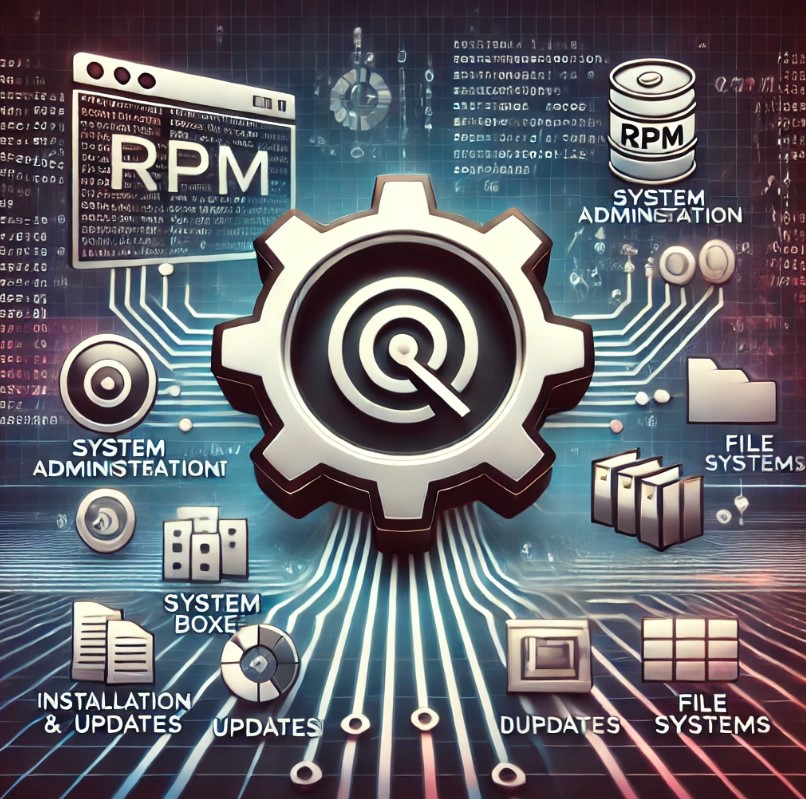Table of Contents
- 1 Introduction
- 2 What is RPM?
- 3 Basic RPM Commands
- 4 Advanced RPM Command Usage
- 5 Advanced Examples for System Administrators
- 5.1 1. Creating and Managing a Custom RPM Database
- 5.2 2. Handling RPM Package Dependencies in an Offline Environment
- 5.3 3. Customizing Pre-Install and Post-Install Scripts (Scriptlets)
- 5.4 4. Verifying Package Integrity Across Multiple Servers
- 5.5 5. Forcing RPM Package Removal While Ignoring Dependencies
- 5.6 6. Tracking Down and Fixing RPM Database Corruption
- 5.7 7. Creating a Local RPM Repository
- 5.8 8. Building Custom RPM Packages for Enterprise Deployment
- 5.9 9. Auditing RPM Activity for Compliance
- 5.10 10. Using RPM with Automation Tools
- 6 Frequently Asked Questions (FAQs)
- 6.1 What is the RPM command line in Linux used for?
- 6.2 Can I install multiple RPM packages at once?
- 6.3 What should I do if an RPM package has unresolved dependencies?
- 6.4 How can I check if a specific package is installed on my system?
- 6.5 Can I verify the integrity of all installed packages at once?
- 6.6 How do I force the installation of an RPM package?
- 6.7 What’s the difference between -i and -U in RPM commands?
- 7 Conclusion
Introduction
The RPM command line in Linux is a powerful tool for managing software packages on Linux distributions that are based on Red Hat, such as RHEL, CentOS, and Fedora. RPM, short for Red Hat Package Manager, allows administrators to install, upgrade, remove, and verify software packages, making it an essential command for maintaining software on a Linux system.
In this article, we will explore rpm command line in Linux from a beginner’s perspective to advanced usage scenarios. Whether you’re a system administrator managing multiple servers or just a curious Linux user, mastering the rpm command can significantly improve your software management skills.
What is RPM?
RPM (Red Hat Package Manager) is the default package management system used by Red Hat-based distributions. It helps you manage the installation, upgrading, verification, and removal of software packages.
An RPM package is usually distributed as a file with the .rpm extension and contains the binaries, libraries, configuration files, and metadata required by the software.
The rpm command provides a direct way to interact with these packages from the terminal.
Advantages of RPM command
- Efficient package management for large systems.
- Advanced verification and query tools.
- Dependency management with integration to other tools like
yumanddnf.
Basic RPM Commands
Installing Packages
To install a new RPM package, you can use the -i option followed by the name of the package.
rpm -i package_name.rpmExample
rpm -i httpd-2.4.6-90.el7.x86_64.rpmThis command installs the Apache HTTP server on your system.
Upgrading Packages
To upgrade an already installed package or install it if it’s not present, you can use the -U (upgrade) option:
rpm -U package_name.rpmThis ensures that the old package is replaced with the new version.
Example
rpm -U httpd-2.4.6-90.el7.x86_64.rpmIf the package is already installed, it will be upgraded; if not, it will be installed as a fresh package.
Removing Packages
To remove a package, you can use the -e option (erase):
rpm -e package_nameThis command will remove the package from your system.
Example
rpm -e httpdThis removes the Apache HTTP server from your system.
Querying Installed Packages
To view a list of installed packages on your system, you can use the -qa option:
rpm -qaIf you want to search for a specific package, you can use grep with it.
Example
rpm -qa | grep httpdThis will display any installed packages related to Apache HTTP server.
Verifying Packages
Sometimes it’s important to verify whether an installed package has been altered or is still in its original state. Use the -V option for this:
rpm -V package_nameExample
rpm -V httpdThis will check the integrity of the Apache HTTP server package.
Advanced RPM Command Usage
Once you’ve mastered the basic RPM commands, it’s time to explore the advanced features of the rpm command line in Linux.
Installing Packages Without Dependencies
By default, RPM checks for dependencies and prevents installation if dependencies are not met. However, you can bypass this with the --nodeps option:
rpm -i --nodeps package_name.rpmExample
rpm -i --nodeps custom_package.rpmUse this option carefully as ignoring dependencies can break your system.
Installing Packages Forcefully
If you want to install a package even if an older version is already present, use the --force option:
rpm -i --force package_name.rpmExample
rpm -i --force httpd-2.4.6-90.el7.x86_64.rpmChecking Package Dependencies
You can check the dependencies required by a package using the -qR option:
rpm -qR package_nameExample
rpm -qR httpdThis will list all the packages that the Apache HTTP server depends on.
Querying Package Information
To get detailed information about an installed package, use the -qi option:
rpm -qi package_nameExample
rpm -qi httpdThis command provides details such as the package version, description, build date, and more.
Listing Files Installed by a Package
To list the files that are part of a package, use the -ql option:
rpm -ql package_nameExample
rpm -ql httpdThis will show all files installed by the Apache HTTP server package.
Building RPM Packages
If you are developing software and want to distribute it as an RPM package, you can use the rpmbuild tool.
- First, prepare the source code and a
.specfile. - Then use the following command to build the RPM package:
rpmbuild -ba package_name.specThe .spec file contains information like the package name, version, release, and instructions on how to compile and install the software.
Advanced Examples for System Administrators
For system administrators managing enterprise-level Linux systems, mastering RPM can enhance package management efficiency, troubleshoot dependencies, and automate common tasks. Below are some advanced use cases and examples tailored to system administrators.
1. Creating and Managing a Custom RPM Database
In enterprise environments, managing packages across multiple systems requires the creation of custom RPM databases. This can be helpful when managing packages outside of the standard repositories.
Creating a Custom RPM Database
To create a separate RPM database in a custom directory:
mkdir -p /var/lib/rpmdb/customdb
rpm --initdb --dbpath /var/lib/rpmdb/customdbInstalling Packages to the Custom Database
Once the custom database is initialized, you can install RPM packages into it using the --dbpath option:
rpm -i --dbpath /var/lib/rpmdb/customdb package_name.rpmQuerying Packages from the Custom Database
To list the installed packages in the custom database:
rpm --dbpath /var/lib/rpmdb/customdb -qa2. Handling RPM Package Dependencies in an Offline Environment
For systems that lack internet connectivity or are in secure environments, resolving package dependencies can be a challenge. One solution is to pre-download all dependencies and install them manually.
Downloading RPM Packages and Dependencies
Use yumdownloader to fetch an RPM package and all its dependencies. This is especially useful if you need to transport packages to an offline system.
yumdownloader --resolve package_nameInstalling Downloaded RPMs
Once downloaded, transfer the RPMs to your offline system and install them using the following command:
rpm -ivh *.rpmThis installs the package and its dependencies in one go.
3. Customizing Pre-Install and Post-Install Scripts (Scriptlets)
RPM allows you to automate tasks during package installation through scriptlets. These can be extremely useful in an enterprise environment for automating configuration tasks.
Viewing Scriptlets of an RPM Package
To view the pre-install, post-install, pre-uninstall, or post-uninstall scriptlets:
rpm -qp --scripts package_name.rpmAdding Scriptlets in Your Own RPM Package
Here’s an example of how to add a scriptlet to an RPM spec file:
%pre
echo "Pre-installation script running"
%post
echo "Post-installation script running"In these scripts, you can automate tasks like starting a service, updating configurations, or performing security tasks after the installation.
4. Verifying Package Integrity Across Multiple Servers
In environments with many servers, it’s crucial to ensure that packages remain consistent and unmodified. Use the rpm -Va command to check the integrity of all installed packages.
Verifying All Installed Packages
This command checks the integrity of all packages by comparing them with their metadata:
rpm -VaInterpreting the Output
- Missing files will be marked with “missing”.
5indicates a checksum mismatch.Mdenotes that file permissions have changed.
Running Verification Across Multiple Servers with Ansible
Ansible can help automate this process across multiple servers. Here’s an example Ansible playbook:
- name: Verify installed RPM packages on all servers
hosts: all
tasks:
- name: Run RPM verification
command: rpm -Va
register: rpm_output
- name: Display verification results
debug:
var: rpm_output.stdout_linesThis playbook runs rpm -Va on all hosts and outputs the results.
5. Forcing RPM Package Removal While Ignoring Dependencies
Occasionally, you’ll need to force the removal of a package that has dependencies, without uninstalling those dependencies. The --nodeps option allows you to force package removal, ignoring dependencies.
Example Command
rpm -e --nodeps package_nameCaution: This can potentially leave your system in an unstable state, so always use this option carefully.
6. Tracking Down and Fixing RPM Database Corruption
RPM database corruption can lead to package management issues, such as packages not installing correctly or becoming unmanageable. You can resolve these problems by rebuilding the RPM database.
Rebuilding the RPM Database
rpm --rebuilddbThis command reindexes the RPM database and can fix many issues related to corruption.
Verifying Package Integrity After Rebuilding
After rebuilding the database, it’s a good practice to verify all packages to ensure nothing was affected:
rpm -Va7. Creating a Local RPM Repository
In a large-scale environment, administrators might need to set up their own RPM repository for internal use. This allows you to control which packages and versions are available.
Setting Up a Local RPM Repository
First, create a directory to store the RPM packages:
mkdir -p /var/www/html/repo
cp *.rpm /var/www/html/repoNext, create the repository metadata using the createrepo tool:
createrepo /var/www/html/repoNow, you can configure your systems to use this local repository by adding it to their /etc/yum.repos.d/ configuration files.
Example Configuration for /etc/yum.repos.d/local.repo
[local-repo]
name=Local RPM Repo
baseurl=http://your-server-ip/repo
enabled=1
gpgcheck=08. Building Custom RPM Packages for Enterprise Deployment
System administrators often need to create custom RPM packages for internal tools and scripts. You can build your own RPMs using rpmbuild.
Setting Up rpmbuild Environment
First, install the required tools:
yum install rpm-buildNext, create the required directory structure:
mkdir -p ~/rpmbuild/{BUILD,RPMS,SOURCES,SPECS,SRPMS}Writing the Spec File
The .spec file contains the metadata and instructions to build the RPM package. Here’s a basic example:
Name: example-package
Version: 1.0
Release: 1%{?dist}
Summary: Example custom package for internal use
License: GPL
Source0: %{name}-%{version}.tar.gz
%description
This is an example package.
%prep
%setup -q
%build
make
%install
make install DESTDIR=%{buildroot}
%files
/usr/local/bin/example
%changelog
* Thu Oct 5 2023 Admin <admin@example.com> - 1.0-1
- Initial build
Building the Package
Run the following command to build the RPM:
rpmbuild -ba example-package.specThis generates the RPM and SRPM (Source RPM) files in your RPMS and SRPMS directories, respectively.
9. Auditing RPM Activity for Compliance
For compliance purposes, system administrators may need to track RPM package activities such as installations, removals, or upgrades.
Viewing the RPM Transaction History
You can view RPM transaction logs using the following command:
rpm -qa --lastThis will display a list of installed packages along with the date they were installed or upgraded.
Example Output
httpd-2.4.6-90.el7.x86_64 Tue 05 Oct 2023 12:00:00 PM UTC
vim-enhanced-8.0.1763-15.el7.x86_64 Mon 04 Oct 2023 11:45:00 AM UTCThis can be useful for auditing package installations in compliance with security or organizational policies.
10. Using RPM with Automation Tools
In a large-scale environment, RPM package management can be automated using tools like Puppet, Chef, or Ansible. Here’s an example of using Ansible to automate RPM installations.
Automating RPM Installations with Ansible
Here’s a simple Ansible playbook to install an RPM package across multiple servers:
- name: Install RPM package on all servers
hosts: all
tasks:
- name: Install package
yum:
name: /path/to/package_name.rpm
state: presentThis playbook installs the specified RPM on all servers listed in the inventory.
Frequently Asked Questions (FAQs)
What is the RPM command line in Linux used for?
The RPM command line in Linux is used for managing software packages on Red Hat-based distributions. It allows you to install, update, remove, query, and verify packages.
Can I install multiple RPM packages at once?
Yes, you can install multiple RPM packages simultaneously by specifying their names separated by a space:
rpm -i package1.rpm package2.rpmWhat should I do if an RPM package has unresolved dependencies?
If a package has unresolved dependencies, it’s best to install those dependencies first. Alternatively, you can use yum or dnf package managers which handle dependencies automatically.
How can I check if a specific package is installed on my system?
You can check if a package is installed using the following command:
rpm -qa | grep package_nameCan I verify the integrity of all installed packages at once?
Yes, to verify all installed packages, use the -Va option:
rpm -VaHow do I force the installation of an RPM package?
You can force the installation of a package using the --force option:
rpm -i --force package_name.rpmWhat’s the difference between -i and -U in RPM commands?
The -i option installs a package, while -U upgrades the package if it’s already installed, or installs it if not.

Conclusion
Mastering the rpm command line in Linux can significantly enhance your ability to manage software on Red Hat-based systems. With its wide range of options, RPM gives system administrators full control over package management. Whether you are installing, upgrading, verifying, or removing packages, knowing how to effectively use RPM will ensure smooth system operations.
By following the commands and examples from basic to advanced in this guide, you can confidently manage packages on your Linux system. Remember to use advanced options like --force and --nodeps with caution, as they can potentially destabilize your system. Thank you for reading the DevopsRoles page!

